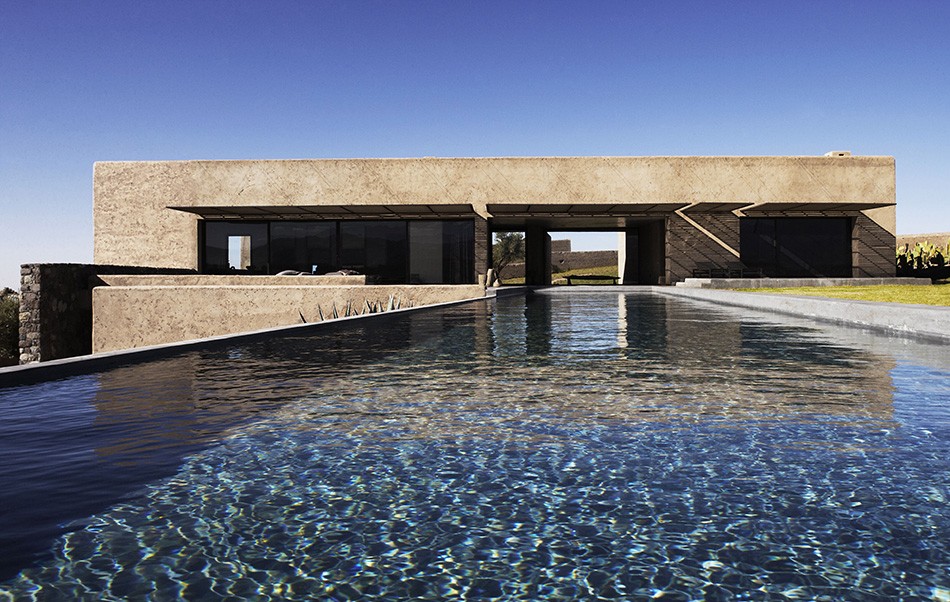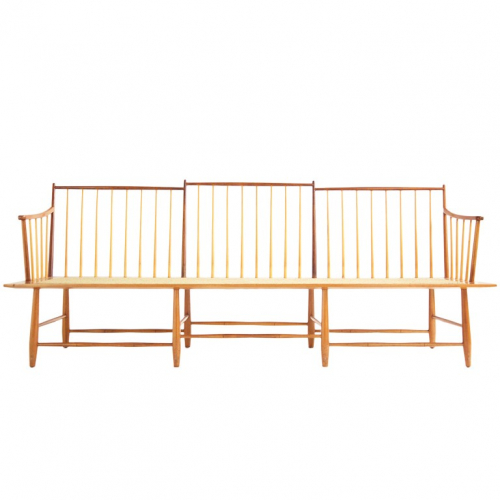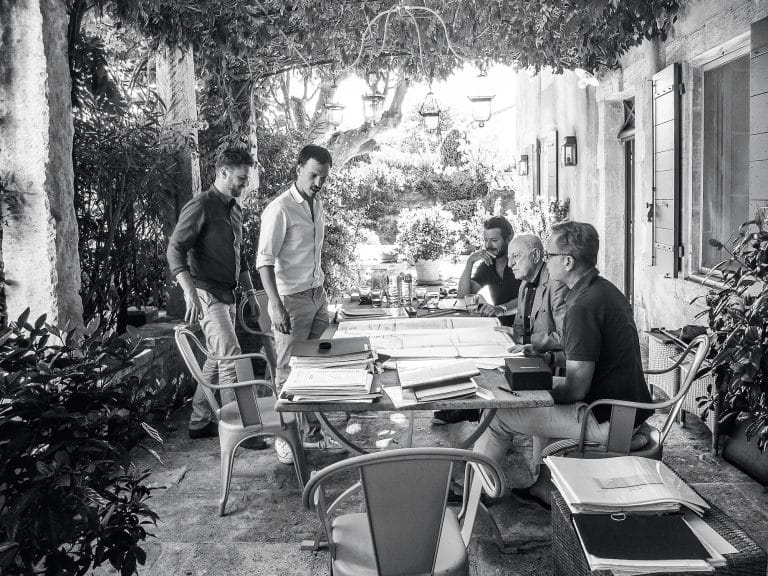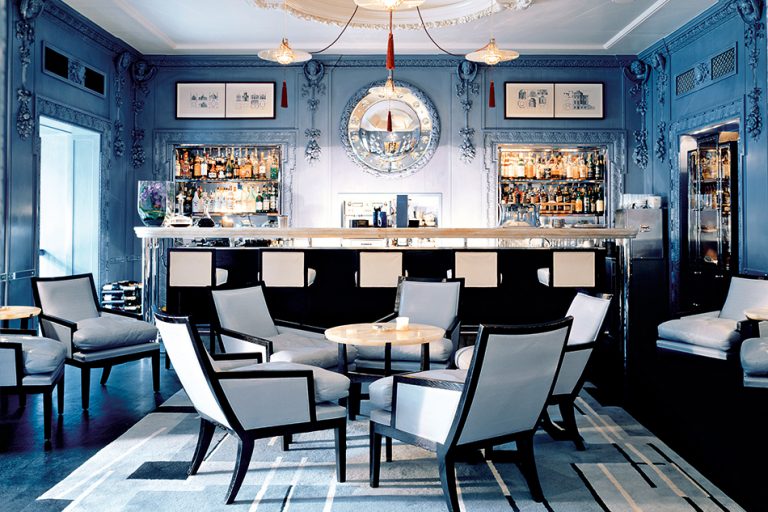
November 2014Olivier Marty (left) and Karl Fournier, partners in life and work, comprise the much in-demand, multinational architecture firm Studio K/O. Photo by Noël Manalili
Karl Fournier and Olivier Marty, the duo behind the architectural firm Studio KO, are rarely in one place for very long. They have offices in Paris, Marrakech and London, and projects in destinations as far-flung as Gabon, Los Angeles and Corsica. This life of constant travel perfectly suits Marty. “It gives me a lot of energy,” he says. “I like being on the move.” Fournier, however, aspires to a slightly more sedate existence. “My parents have given up knowing where I am,” he admits. “I send them an e-mail to say I’m in Morocco, and by the time they’ve opened it, I’m already somewhere else.”
Recently, the pair has spent a significant chunk of time in the British capital, overseeing the design of Chiltern Firehouse — the first European establishment of André Balazs, the man behind, among other properties, the Standard hotels in New York, Los Angeles and Miami. Over dinner in the hotel’s restaurant in April with Fournier and Marty, I spotted Tom Ford at a neighboring table. During the tour of the then-still-not-opened guest rooms that followed, the designers recounted how Kate Moss and Bono had recently played ping-pong in the bar.

In a house in Luberon, France, completed in 2008, the duo paired a sofa by Piero Lisoni for the Italian company Living Divani with a bench by Harry Bertoia. Photo by Dan Glasser
Part of the inspiration for the hotel’s design came from the building itself — a former fire station in London’s posh Marylebone district. “From the exterior, it looks like a small castle,” notes Fournier, “but once you walk inside, it’s very industrial.” They kept that spirit, most notably with the factory-style lighting in the restaurant, and incorporated a number of references to its past: There is a fireman’s pole in one corner of the dining room, and the doors to the 29 guestrooms are painted fire-engine red. The rest of the decor has a charmingly old-fashioned spirit. With its wicker chairs, floral fabrics and hanging plants, the bar feels distinctly Edwardian, while the moody guestrooms feature 19th-century-style Madeleine Castaing carpets and bedside tables covered in fabric edged with studs.
Balazs originally discovered Studio KO’s work after staying at L’Heure Bleue, a hotel they designed from the ground up in the Moroccan seaside resort of Essaouira, which opened in 2004. Their aim was for it to resemble a traditional family home, and what particularly struck Balazs was its sense of place. “He told us, ‘It’s a hotel that could not exist anywhere else in the world,’ ” Fournier recalls. With amusement, Marty adds that guides to the town’s medina regularly inform tourists that the building dates from the 18th century.

When not jetting from one country to the next, the couple lives in a converted factory on the outskirts of Paris. Photo by Noël Manalili
It took Balazs some time to track the pair down. When they were first informed he had called their office, they thought it was a prank. “He had to be really insistent,” recalls Fournier. “We didn’t call back the first few times.” They are glad they finally did, however, especially because their collaboration is not limited to the Firehouse. They are also currently working on tweaking Balazs’s iconic Château Marmont in Los Angeles, creating new bathrooms and making quasi-invisible improvements to the bedrooms. “The aim is that people don’t notice the difference,” says Marty.
In person, the two are equally charming but in complementary ways. Marty is direct and gregarious, Fournier more dreamy and ultimately more expansive. They met in February of 1996 while studying architecture at Paris’s School of Fine Arts. There was an immediate romantic attraction but not a common approach to work. “Olivier was more pragmatic, whereas I was really into conceptual things,” says Fournier, who was born in Saint-Raphaël in the south of France and is now 44. His grandmother was an architect in Tunisia in the 1940s, and he still recalls drawers filled with her plans in the family’s holiday home on Corsica. “I was always fascinated by them,” he says. He initially trained to become an actor but switched to architecture after failing the entrance exam to the Paris Conservatoire. “For me, it was that — the best school — or nothing,” he asserts.
It took Balazs some time to track the pair down. When they were first informed he had called their office, they thought it was a prank.

At the home of fashion mogul Pierre Bergé in Tangier, Morocco, a vintage 1940s Murano glass chandelier hangs above a vintage table from India topped by a Turkish Iznik ceramic jar. The two mother-of-pearl side tables are from Syria and the mirror is 19th century. Photo by Philippe Garcia
Marty, 39, was brought up in a scientific family (his father was a nuclear physicist) who lived just south of Paris and he remembers drawing imaginary worlds from an early age. “I don’t know where it came from, but I was always sensitive to buildings, geography and landscapes,” he says.
Fournier and Marty founded their own firm in April 1999, a few months before graduation. Many of their early projects were in Morocco — a country they had first visited together a few months after becoming a couple. “I was fascinated to see that people could live so differently from us,” says Fournier, “that two times existed in parallel.” Marty, meanwhile, notes that the country instilled in them a love of handicrafts, which has remained a constant part of their work, whether in their use of Italian enamel tiles or penchant for painted walls in which the brushstrokes are still dramatically evident.
Their first big break came when Patrick Guerrand-Hermès (a member of that Hermès family) commissioned them to design a house on a beach outside Tangier. Fournier still clearly remembers their first meeting with Guerrand-Hermès in Paris: “He said to me, ‘You have to meet my wife. Come to dinner tomorrow!’ I thought he was talking about Paris, but he meant Morocco!” Their projects since have included the renovation of painter Jacques Majorelle’s studio in Marrakech, boutiques for luxe skincare brand Aesop in London and the fashion brand Ami in Paris, plus several restaurants in the French capital.

In one of their trademark minimalist villas, this one located in Tagadert, Morocco, a desk and a bed designed by Studio KO easily blend with a black Eames chair and an armchair by Sergio Rodrigues. Photo by Dan Glasser

A Sling sunbed by Boffi Bains offers a sculptural seating option beside the pool of the Luberon house. Photo by Dan Glasser
They are perhaps best known, however, for a series of rigorous, minimalist villas with monochromatic interiors set in spectacular landscapes in both France and Morocco. The style is a far cry from the more ornamental Chiltern Firehouse or Le Chardenoux des Prés, their 2011 brasserie in Paris’s Saint Germain-des-Prés, and they are the first to admit there is a curious dichotomy in their output. “We’re constantly torn between our desire for extremely pared-down, pure things and a more decorative, busy aesthetic,” Fournier says. “And it’s not a case of Olivier doing one and me doing the other. It’s something that exists in both of us.” One common denominator, however, is that they are heavily influenced by context. “Each time, they’re completely in tune with the environment,” notes Pascale Mussard, the director of the Petit h department at Hermès, who has known them for more than a decade. “They take absolutely everything into account.”
A perfect example is one of their current projects, an 84-room luxury hotel built largely out of wood in Libreville, capital of Gabon, in Central Africa. They see it as a form of promotion for the country’s forestry industry — the most important in Africa. Also on the drawing board are residential projects in Morocco, Corsica, Brittany and Paris, plus a new Yves Saint Laurent museum in Marrakech, due to open in 2016. Beyond that, they still have a number of professional ambitions — most notably to design a place of worship and a wellness center (be it a public hammam or thermal baths). Fournier, in particular, could find respite in either place if Studio KO’s frenetic work schedule ever becomes too much. For now, however, he says his dream “is just to be able to tell people where I’ll be in a month!”
Studio KO’s Quick Picks on 1stdibs















